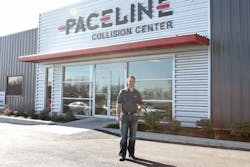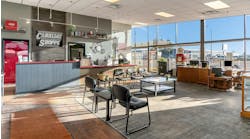When Jeremy Mulcahy first started as production and facility manager at Paceline Collision Centers more than a decade ago, his knowledge of the automotive industry was limited to knowing how to clean his own car. Now as the production and facility manager at Paceline in Killeen, Texas, Mulcahy prides himself on running a lean shop that always operates ahead of schedule.
My day starts kind of backwards; I have a release_notes meeting every day at 4:45 p.m. to set up for the following day. The meeting includes our lead tech, along with our blueprinter, who is our estimator in the shop, and our service advisors, who report to the customer.
For a production manager, I think the key is being proactive versus reactive. You have to utilize the tools at your disposal to identify not only what’s due today, but looking at what’s due three days from now. It’s really about trying to forecast your own production, which is especially useful if you have a management program. If you look at what is due out the next day or two and then put those cars in process, you’ll hit the target dates you promised the customer. To make sure that happens, you need to organize your production sheets well. That’s why we have an end-of-the-day release meeting—to ensure that we are proactive.
When I show up the next morning, I start by doing a walk around. I look at what the techs have already completed, if we had any surprises or hang-ups, and figure out if we’re ahead of schedule.
One of my strongest attributes is leadership and staying ahead of the game. Part of good leadership is organization and extending that organization throughout all aspects of the shop. You always need a game plan, so the technicians know what’s coming and you’re not stuck in reaction mode.
That way they’re not coming to you asking, “Hey, what’s my next job?” You’ve already forecasted their jobs for the next three days, so it keeps them on task. The technicians are more efficient when they don’t have to come looking for the production manager all the time. If your guys are paid on commission and you’ve got multiple jobs signed out for them, it’s going to provide the motivation to get those jobs done. They’re bought in and taking ownership of their work.
Another aspect of being a good leader is getting to know your people. I take the time to make sure I know my techs. I want to know what’s going on in their lives or if there’s anything we can help them with. It shows that you care and establishes a sense of trust. Your techs truly are your biggest asset, and if you don’t have good technicians, nothing else will work.
I begin preparing for our next release meeting around 10 a.m. We have two more release meetings throughout the day: one at 10 a.m., and then another one in the afternoon after lunch. It’s a quick meeting—no more than five or 10 minutes—where we check on our progress for the day. If there are any bottlenecks, we try to resolve those issues. For example, do we need to load-level techs to a certain department? Again, it’s about being proactive and achieving our goals for the day.
One of the goals in our shop is to really focus on lean processing. I’ve had the opportunity to attend several 20 Group meetings, which introduced me to the idea. Since then, we’ve really made it a priority to change our thought process and adopt a more lean approach. We moved to blueprinting and doing complete teardowns, which dropped our supplement rate and also decreased our cycle time.
A big part of our approach is focusing on pull production versus push production. What I mean by that is instead of pushing cars to departments, we’re pulling cars from departments. A traditional shop pushes cars; they work off a Monday through Friday schedule: Let’s get everything in by Monday and have it out by Friday. The problem with that is, you’ll flood the departments. If you just try to get whatever you can to paint, you’ll create a bottleneck and paint will completely flood.
Instead, if I know we can only paint six booth cycles and I have six cars in line plus more on the way, I’ll tell my body team to stop pushing those jobs to paint. They can’t handle it right now, so we focus on teardowns that are coming in or getting some cars out if they’re in reassembly. Our shop also has two paint teams, so if one team is bottlenecked, sometimes we’ll move the other team over to help them get caught up.
The goal is to resolve the bottleneck and pull them out of paint into reassembly as quickly as possible, so we can get back on track. We try to move cars every hour-and-a-half through paint, so pull production really helps solve those bottlenecks and everyday issues.
In the hours between meetings, I’m at my desk strategizing. I use the time to either refocus or readjust my production plan, as the case may be. If it looks like we’re going to be late on a job, I’ll need to make a call to the customer. I always want to make sure we’re still on target for the upcoming days, so I spend time in our management program looking at the days ahead and figuring out how to get everything done.
This year will be my 11th year in the business, but I didn’t really feel comfortable until I was about three years in. That’s when I started to feel more comfortable and confident with my production plan.
When I started, I didn’t know anything about cars; it was a real learning process to gain that knowledge. Over time, you find out how long it really takes to make a repair, what goes on in the back. You see the cut-ins and parts deliveries. Eventually I just got a general feel for the whole industry and how it works.
Throughout the years, I’ve learned that an experienced production manager is essential. I’m the one setting the target dates, and the front office is counting on us to hit those dates, so they can make accurate projections to the customers. As far as CSIs, the production manager is a huge asset. Poor CSIs will affect your insurance relationships. If you’re not getting the cars out on time, you’ll get phone calls from your DRP partners. Overall, a good production manager is fundamental to a successful shop.
Anna Zeck contributed to this article.



